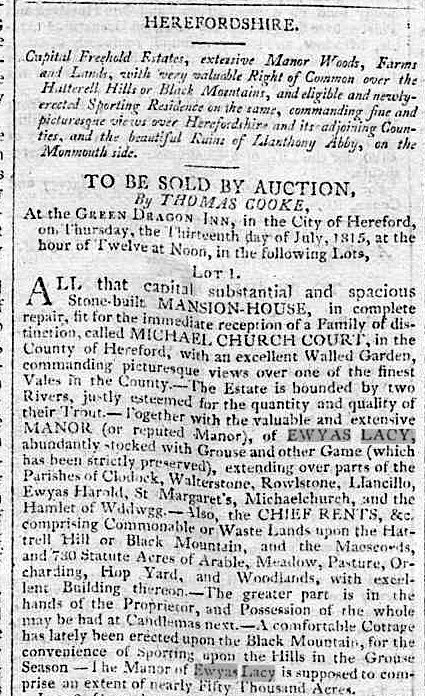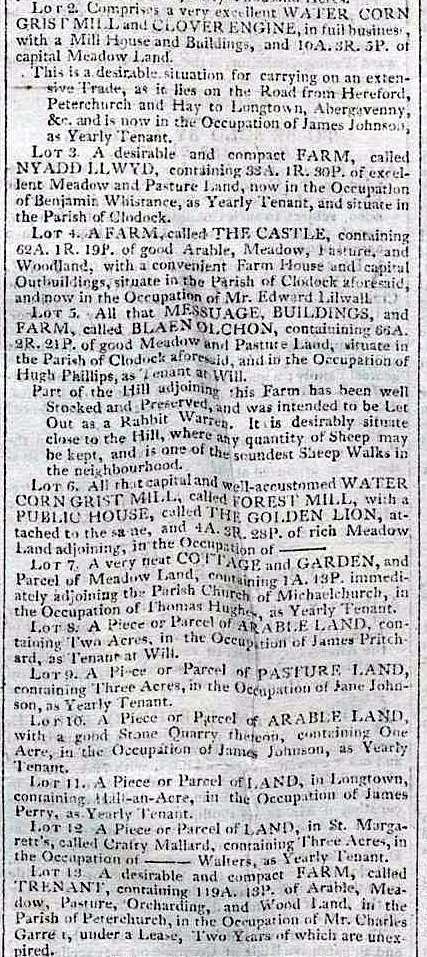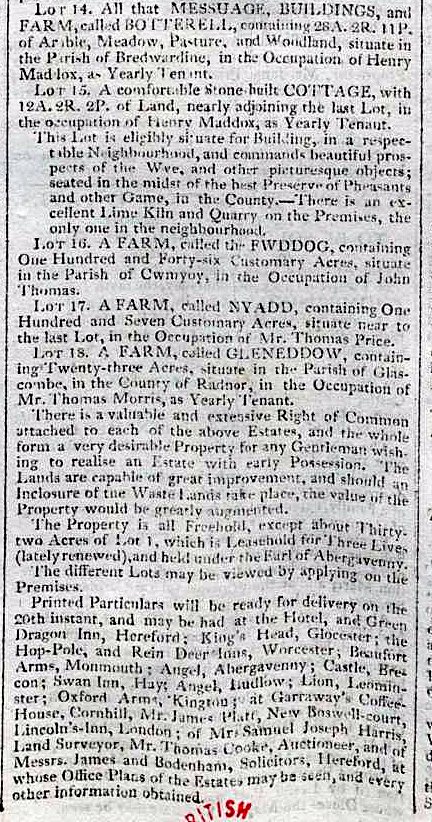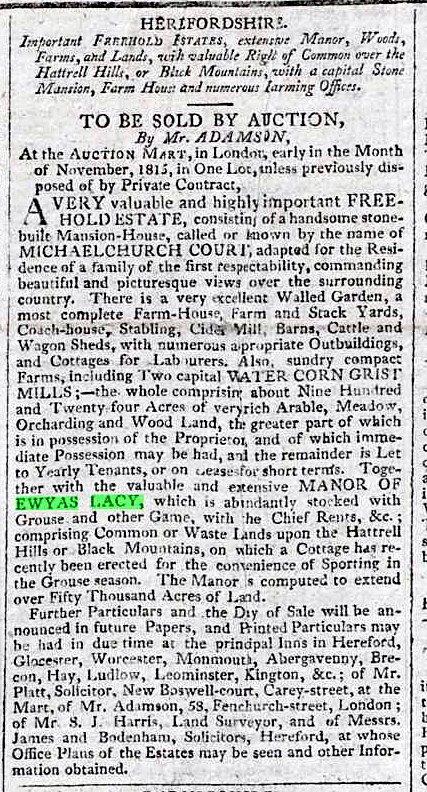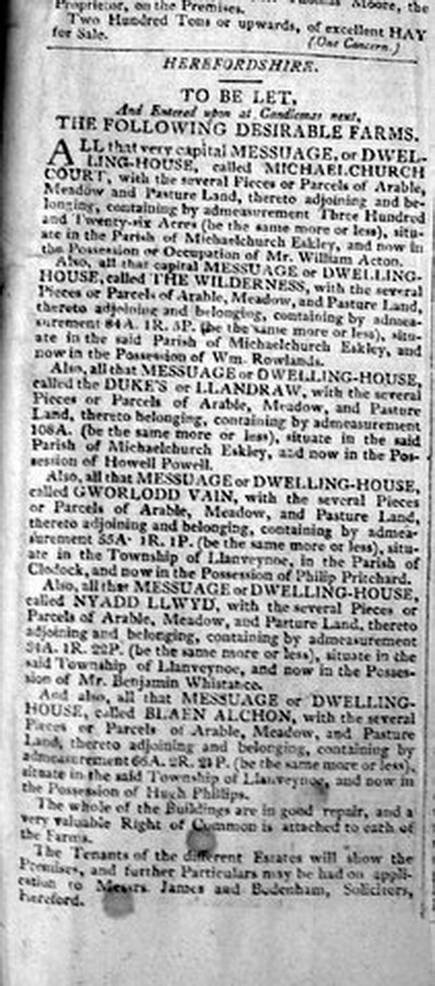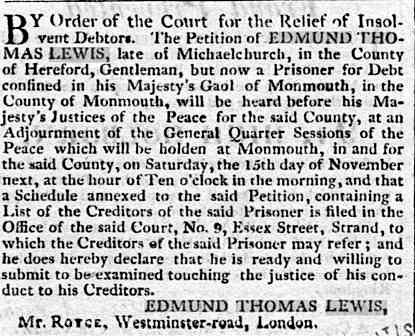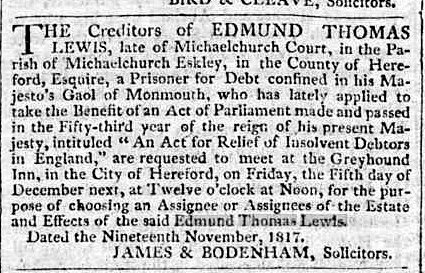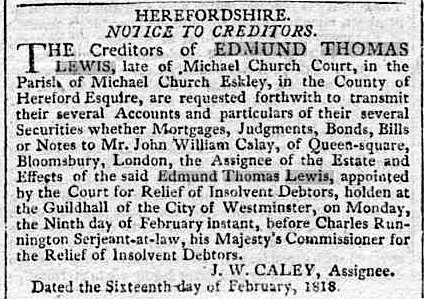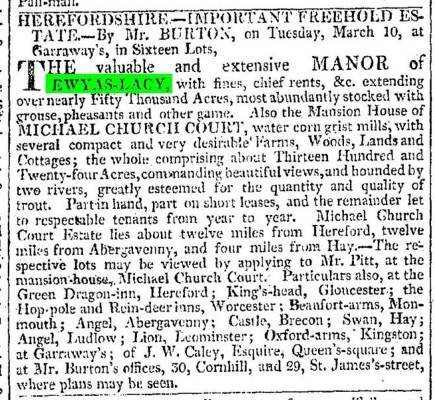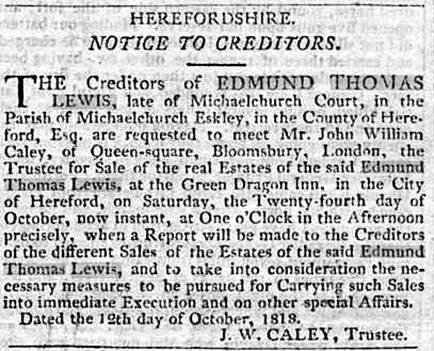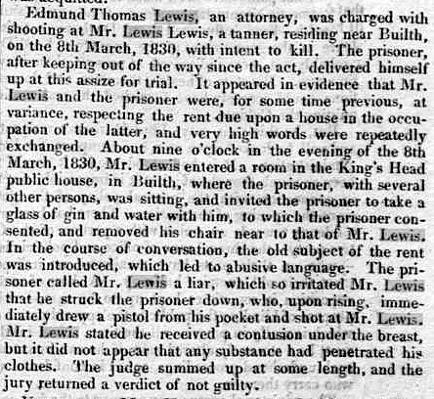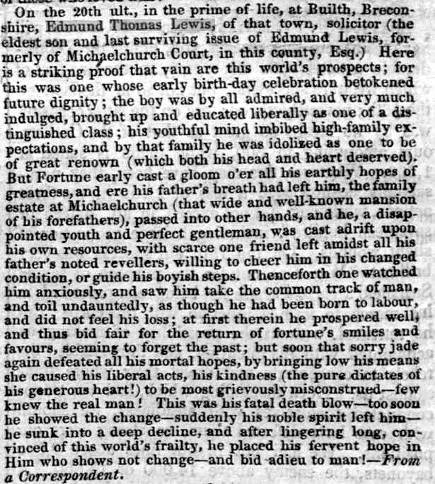Title: | The Thomas Family at Michaelchurch Court |
Date: | 1566 - 1818 |
The Thomas Family at Michaelchurch Court 1566 - 1818
By Bob Steele
In the early sixteenth century the freehold tenancy of the messuage and lands that were to become the Michaelchurch Court farm and heart of the later Michaelchurch Court Estate was acquired by David Thomas, Gent., described in the Visitation of Herefordshire in 1634 as an attorney in the Marches of Wales. He was established in possession by 1566 when Queen Elizabeth I gave title of a moiety of the manor of Ewyas Lacy to her favourite, Robert Dudley Earl of Leicester, who commissioned a survey of the Manor which identifies the Thomas holdings. Despite several subsequent changes in title to the Manor including its sequestration from Lord Hopton by Parliament during the Civil War, its recovery after the restoration of the Monarchy by descendants of the Hopton family when conflicting claims were eventually settled in the Chancery Court, and the subsequent sale of the manorial rights to John Jeffreys of Brecon, the Thomas family would keep the freehold tenancy of the Court and other lands in the area for the next two hundred and fifty years.
When David Thomas died circa 1603 the freehold passed to his son Leison [Leyson] Thomas and then in turn to Leison’s eldest son Michael Thomas. Michael died in 1670 at the age of 76, passing the property to his son Edward who died the following year at the age of 57, leaving his young son Humphrey Thomas to come into his inheritance in 1683 when he reached the age of eighteen. Humphrey died in 1732 at the age of 67 whereupon the estate passed to his son Edmund Thomas, who died in 1757 as the last of the direct male Thomas line. The freehold to the property was then inherited by John Lewis who is described as a kinsman of Edmund Thomas, and who held Michaelchurch Court and the associated land and farms until his death in 1795 at the age of 86. The property then passed to his son Edmund Thomas Lewis.
The tenure of Edmund Thomas Lewis would bring the centuries of ownership of Michaelchurch Court and associated properties by the descendants of the Thomas family to a close. According to contemporary accounts Edmund was a man of extravagant tastes who associated with 'noted revellers'. The implication is that his financial and other excesses squandered his inheritance; in any event the income from the estate was evidently insufficient to support his lifestyle and his fall from the gentry to a debtor’s prison and eventual bankruptcy is chronicled in the pages of the Hereford Journal at the time.
The first public sign of trouble appeared in 1815 when he put the freehold of Michaelchurch Court and about 1,364 acres of land up for auction, presumably to pay off his mounting debts. The advertised sale package also included the rights to the Manor of Ewyas Lacy, or at least that part of it which was held by the Jeffreys family heirs who apparently had their own reasons to take the opportunity to dispose of their interests after the death of Walter Jeffreys in 1813. The sale was heavily advertised in local newspapers and presented the property in eighteen lots to be auctioned at the Green Dragon Inn, Hereford on 13th July 1815. The lots included the mansion house with walled garden and land called Michaelchurch Court, Michaelchurch water corn and grist mill with clover engine, Church Cottage Michaelchurch, Nyadd LLwyd farm, The Castle farm, Blaen Olchon farm, a water corn grist mill called Forest Mill with a public House called the Golden Lion attached, Trenant farm in the parish of Peterchurch, Botterell farm in the parish of Bredwardine, Fwddog farm and Nyadd farm in the parish of Cwmyoy, Gleneddow farm in the county of Radnor, a stone quarry, several cottages and parcels of land and extensive Rights of Common and manorial rights across Ewyas Lacy supposedly extending to nearly fifty thousand acres .
|
|
|
|
|
|
| Hereford Journal 21st June 1815 |
However, the sale on 13th July 1815 in Hereford was apparently unsuccessful and the matter was taken out of the hands of local auctioneers and entrusted to ‘The Auction Mart’ in London for another attempt. Their sale was scheduled for early November 1815 and was extensively advertised, including in the Hereford Journal each week from 27th September to 1st November
|
|
| Hereford Journal 18th October 1815 |
It appears that the London auctioneer fared no better than the local man in Hereford, and also failed to attract any offers at an acceptable price. Edmund Thomas Lewis resorted to trying to let the property to generate an income - the Hereford Journal of December 25th 1816 contains an advertisement offering Michaelchurch Court with 326 acres of land, currently in the occupation of William Ashton, and the ‘desirable farms’ at The Wilderness, Llandraw, Gworlodd Vain, Nyadd Llwyd and Blaen Olchon to be let from the following Candlemass.
|
|
| Hereford Journal 25th December 1816 |
These steps evidently proved insufficient and by October 1817 Edmund Thomas Lewis had been incarcerated by his creditors as a 'prisoner for debt' in Monmouth goal. There he took advantage of a new 'Act for Relief of Insolvent Debtors' that had been passed by Parliament in 1813. This allowed him in effect to declare himself bankrupt and apply to the Courts to be released from prison. An advertisement in the Hereford Journal on 22nd October 1817 advises creditors that his petition to the Court for the Relief of Insolvent Debtors would be heard before the Justices of the Peace in the General Quarter Sessions at Monmouth on 15th November where he would be ' ready and willing to be examined touching the justice of his conduct to his creditors'.
|
|
| Hereford Journal 22nd October 1817 |
The legal examination appears to have been successful so far as it went. We may presume that Edmund Thomas Lewis was released from prison under the provisions of the Act, but that his property and affairs were placed in the hands of the lawyers and his creditors. A further advertisement on 19th November 1817 invited his creditors to a meeting at the Greyhound Inn, Hereford to choose an 'Assignee' or Administrator of his estate and effects.
|
|
| Hereford Journal 19th November 1817 |
By February 1818 creditors were advised that the Court for the Relief of Insolvent Debtors had appointed an Assignee of the Estate and were invited to submit full details of their claims to him preparatory to the sale of Edmund Thomas Lewis's assets.
|
|
| Hereford Journal 18th February 1818 |
John William Caley, the court-appointed Assignee of the Michaelchurch Estate wasted no time getting down to business, advertising in London’s Morning Chronicle of 21st February yet another attempt to auction off the Michaelchurch Court and Estate. The sale took place in sixteen lots - as opposed to the eighteen lots of the abortive 1815 sale - on 10th March 1818 at Garraways Coffee House in Cornhill, London, conducted by Mr Burton.
|
|
| Morning Chronicle 21st February 1818 |
On the 21st October 1818 the Hereford Journal published a notice to creditors inviting them to a meeting with the Trustee for Sale of the real estates of Edmund Thomas Lewis at the Green Dragon Hotel in Hereford where 'a report will be made to the Creditors of the different Sales of the Estates ... and to take into consideration the necessary measures to be pursued for carrying such Sales into immediate Execution.'
|
|
| Hereford Journal 21st October 1818 |
The content of the Assignee’s report to the creditors that October is not known, though it would have included the outcome of the March 1818 auction, which was [at least] the third formal attempt to find a purchaser for the whole or parts of the Michaelchurch Court Estate in the period between 1815 and 1818. However, we know from other sources that Michaelchurch Court and Estate was finally purchased, whether at that auction or by subsequent treaty, in or around 1818 by Thomas Daniell, a Gentleman resident in Bath and part of a wealthy Cornish copper and tin mining dynasty. His story is told elsewhere on this website.
As for the subsequent fate of Edmund Thomas Lewis, having fallen from his elevated position as a wealthy gentleman landowner of Michaelchurch Court and Estate he did not long survive the loss of his wealth and the ending of his family’s centuries-old prominence in Ewyas Lacy. A brief report of his death in appears in the obituaries column of the Hereford Journal in 1820, from which we may presume that his lifestyle and its consequences may have taken a heavy toll on his health and that he lived out his final years under his son’s roof in Hay on Wye.
|
|
| Hereford Journal 13th September 1820 |
An even sadder footnote to the story is that his son, also named Edmund Thomas Lewis, who became an Attorney in Hay on Wye and later at Builth Wells after losing his family home at Michaelchurch as a result of his father’s bankruptcy, seems to have inherited at least some of his father’s weaknesses. The Hereford Journal reports in 1833 on Assize Court proceedings against him on charges of shooting a man in a Builth Wells pub in an argument over money.
|
|
| Hereford Journal 23rd March 1833 |
Although he was found not guilty, the circumstances are perhaps a reflection of the lasting blight on his life and prospects arising from the events at Michaelchurch and his father’s bankruptcy. This was eloquently expressed in his obituary written by a correspondent in the Hereford Times in 1837.
|
|
| Hereford Times 1st April 1837 |
This poignant commentary casts a wider perspective on the speed and extent of the downfall of the Thomas family dynasty at Michaelchurch and the misfortunes that followed.
Observations:
Images of newspaper cuttings are courtesy of the British Newspaper Archive at the British Library, with thanks to Neville Fleet who identified and made available the references to individual entries concerning Edmund Thomas Lewis.
A broader history of Michaelchurch Court and Estate is available elsewhere on the History of Ewyas Lacy website.
Ref: rs_mic_0685

